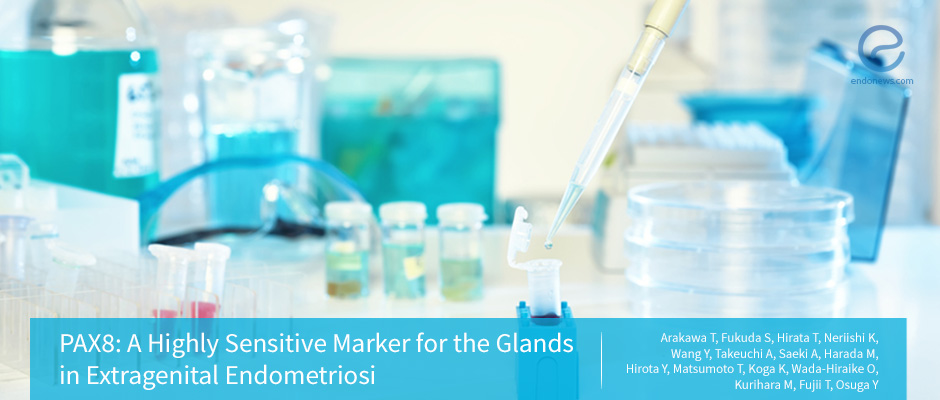PAX8 immunohistochemistry in the diagnosis of Extragenital Endometriosis
Feb 26, 2019
PAX8 is a Sensitive Marker for Diagnosing the Glands in Extragenital Endometriosis
Key Points
Highlights:
- PAX8 is a highly sensitive epithelial marker for extragenital endometriosis, its expression was maintained under hormonal therapy.
- Regardless of different theories on the origin of endometriosis, the extragenital endometriosis maintains PAX8 expression.
Background:
- Endometriosis is seen in many organs including peritoneum, ovaries, bowel, bladder, and even lung.
- Histopathologic diagnosis may be difficult when endometrial stroma is not evident and fibrosis is present. In these cases, the glands may be mistaken for a neoplastic process.
- Glandular epithelium of endometriosis is immunohistochemically positive for ER and PR.
- Stroma of endometriosis can be detected using CD10 immunohistochemistry.
- PAX8
- a transcription factor that belongs to the pair-box (PAX) gene family.
- essential molecule for the development of Müllerian organs, thyroid, and urinary tract
- the nuclear expression can be detected with immunohistochemistry
What's Done Here:
- 8 ovarian and 47 extragenital endometriosis were included in the study. Tissues were immunostained with ER, PR, CD10, and PAX8.
- Extragenital endometriosis locations were: 20 intestinal, 10 bladder, 3 ureteral, 3 inguinal, and 11 diaphragmatic
Key Results:
- PAX8 was positive in 95.7% (45/47) of extragenital endometriosis and in 100% (8/8) of ovarian endometriosis; stained only glandular epithelium of endometriosis.
- was negative in 2 bladder endometriosis.
- Did not stain intestinal epithelium, and the expression was not affected by previous hormonal therapies.
- ER and PR stained both glandular epithelium and stromal cells, in a variable in intensity and percentages, and the ER expression was lower in cases with hormonal treatment.
- CD10 was positive in 97.9% (46/47) of extragenital endometriosis, and it stained only the stromal cells. One intestinal endometriosis was negative, and the expression was not affected by previous hormonal therapies.
Lay Summary
This study is performed by Arakawa T et al., from the University of Tokyo, Tokyo, Japan, and the results are published in Reproductive Sciences.
Endometriosis is seen in many organs including peritoneum, ovaries, bowel, bladder, and even lung. Histopathologic diagnosis may be difficult when endometrial stroma is not evident and fibrosis is present. In these cases, the glands may be mistaken for a neoplastic process. For the differential diagnosis, pathologists are using ER (estrogen receptor), PR (progesterone receptor) expressions in the gland epithelium and CD10 expression in the endometriotic stroma.
PAX8 is a transcription factor that belongs to the pair-box (PAX) gene family. It is an essential molecule for the development of Müllerian organs. Its expression can be detected in the nuclei of glandular epithelial cells. Here the authors investigated the potential use of PAX8 expression in the diagnosis of extragenital endometriosis. They stained ovarian and extragenital endometrial tissues with ER, PR, CD10, and PAX8.
PAX8 is found to be positive in 95.7% (45/47) of extragenital endometriosis and in 100% (8/8) of ovarian endometriosis. PAX8 is a highly sensitive epithelial marker for extragenital endometriosis and PAX8 expression was maintained under hormonal therapy. Therefore PAX8 can be used in clinical practice in the diagnosis of extragenital endometriosis together with other markers.
Research Source: https://www.ncbi.nlm.nih.gov/pubmed/30764713
PAX8 immunohistochemistry diagnosis endometriosis extragenital

